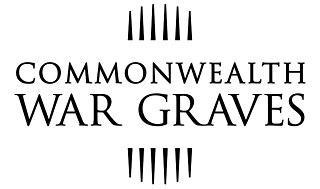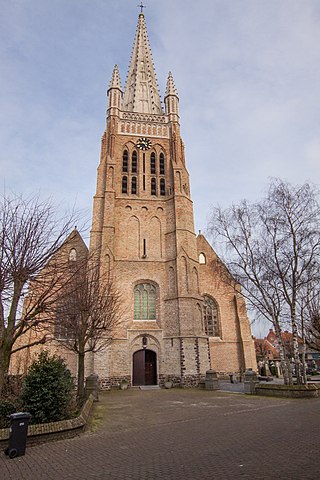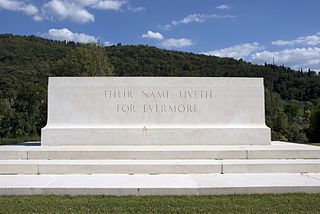
The Commonwealth War Graves Commission (CWGC) is an intergovernmental organisation of six independent member states whose principal function is to mark, record and maintain the graves and places of commemoration of Commonwealth of Nations military service members who died in the two World Wars. The commission is also responsible for commemorating Commonwealth civilians who died as a result of enemy action during the Second World War. The commission was founded by Sir Fabian Ware and constituted through Royal Charter in 1917 as the Imperial War Graves Commission. The change to the present name took place in 1960.

Brookwood Cemetery, also known as the London Necropolis, is a burial ground in Brookwood, Surrey, England. It is the largest cemetery in the United Kingdom and one of the largest in Europe. The cemetery is listed a Grade I site in the Register of Historic Parks and Gardens.

The Willesden United Synagogue Cemetery, usually known as Willesden Jewish Cemetery, is a Jewish cemetery at Beaconsfield Road, Willesden, in the London Borough of Brent, England. It opened in 1873 on a 20-acre (0.08 km2) site. It has been described as the "Rolls-Royce" of London's Jewish cemeteries and is designated Grade II on Historic England's Register of Historic Parks and Gardens. The cemetery, which has 29,800 graves, has many significant memorials and monuments. Four of them are listed at Grade II. They include the tomb of Rosalind Franklin, who was a co-discoverer of the structure of DNA.

The Cross of Sacrifice is a Commonwealth war memorial designed in 1918 by Sir Reginald Blomfield for the Imperial War Graves Commission. It is present in Commonwealth war cemeteries containing 40 or more graves. Its shape is an elongated Latin cross with proportions more typical of the Celtic cross, with the shaft and crossarm octagonal in section. It ranges in height from 18 to 24 feet. A bronze longsword, blade down, is affixed to the front of the cross. It is usually mounted on an octagonal base. It may be freestanding or incorporated into other cemetery features. The Cross of Sacrifice is widely praised, widely imitated, and the archetypal British war memorial. It is the most imitated of Commonwealth war memorials, and duplicates and imitations have been used around the world.

Cane Hill Hospital was a psychiatric hospital in Coulsdon in the London Borough of Croydon. The site is owned by GLA Land and Property.

Fromelles is a commune in the Nord department in northern France. As of 2019 it had a population of 1,041; its inhabitants are called Fromellois. It is located about 16 kilometres (10 mi) to the west of Lille.

Duhallow ADSCemetery is a Commonwealth War Graves Commission burial ground for the dead of the First World War located near Ypres on the Western Front in Belgium.

Boezinge is a village in the municipality of Ypres in the Belgian province of West Flanders. Boezinge can be reached via the N369 road in the direction of Diksmuide. It was an independent municipality until 1977.

Harrogate (Stonefall) Cemetery is a Commonwealth War Graves Commission (CWGC) burial ground for the dead of the First World War and Second World War located on the outskirts of Harrogate in North Yorkshire, England.

The Stone of Remembrance is a standardised design for war memorials that was designed in 1917 by the British architect Sir Edwin Lutyens for the Imperial War Graves Commission (IWGC). It was designed to commemorate the dead of World War I, to be used in IWGC war cemeteries containing 1,000 or more graves, or at memorial sites commemorating more than 1,000 war dead. Hundreds were erected following World War I, and it has since been used in cemeteries containing the Commonwealth dead of World War II as well. It is intended to commemorate those "of all faiths and none", and has been described as one of Lutyens' "most important and powerful works", with a "brooding, sentinel-like presence wherever used".

The English coastal city of Brighton and Hove, made up of the formerly separate Boroughs of Brighton and Hove in East Sussex, has a wide range of cemeteries throughout its urban area. Many were established in the mid-19th century, a time in which the Victorian "cult of death" encouraged extravagant, expensive memorials set in carefully cultivated landscapes which were even recommended as tourist attractions. Some of the largest, such as the Extra Mural Cemetery and the Brighton and Preston Cemetery, were set in particularly impressive natural landscapes. Brighton and Hove City Council, the local authority responsible for public services in the city, manages seven cemeteries, one of which also has the city's main crematorium. An eighth cemetery and a second crematorium are owned by a private company. Many cemeteries are full and no longer accept new burials. The council maintains administrative offices and a mortuary at the Woodvale Cemetery, and employs a coroner and support staff.

Essex Farm Cemetery is a World War I, Commonwealth War Graves Commission burial ground within the John McCrae Memorial Site near Ypres, Belgium. There are 1,204 dead commemorated, of which 104 are unidentified. The cemetery was designed by Sir Reginald Blomfield and has an area of 6,032 square metres (64,930 sq ft).
Weaste Cemetery is a public cemetery in Weaste, Salford, Greater Manchester, in England. Opened in 1857, it is the oldest of Salford's four cemeteries, covering 39 acres and containing over 332,000 graves.

Kohima War Cemetery is a memorial dedicated to soldiers of the 2nd British Division of the Allied Forces who died in the Second World War at Kohima, the capital of the Indian state of Nagaland in April 1944. The soldiers died on the battleground of Garrison Hill in the tennis court area of the Deputy Commissioner's residence. According to the Commonwealth War Graves Commission, which maintains this cemetery among many others in the world, there are 1,420 Commonwealth burials of the Second World War at this cemetery, and a memorial to an additional 917 Hindu and Sikh soldiers who were cremated in accordance with their faith. The memorial was inaugurated by Field Marshal Sir William Slim, then Commander of the 14th Army in Burma.

The South African War Memorial is a First World War memorial in Richmond Cemetery in the London Borough of Richmond upon Thames. Designed by architect Sir Edwin Lutyens, the memorial is in the form of a cenotaph, similar to that on Whitehall, also by Lutyens. It was commissioned by the South African Hospital and Comforts Fund Committee to commemorate the 39 South African soldiers who died of their wounds at a military hospital in Richmond Park during the First World War. The memorial was unveiled by General Jan Smuts in 1921 and was the focus of pilgrimages from South Africa through the 1920s and 1930s, after which it was largely forgotten until the 1980s when the Commonwealth War Graves Commission took responsibility for its maintenance. It has been a grade II listed building since 2012.

Hollybrook Cemetery is a cemetery in Bassett, Southampton, England containing around 53,000 graves as of August 2012 and still open to new burials as of March 2016. It is one of the main cemeteries in Southampton.

Known unto God is a phrase used on the gravestones of unknown soldiers in Commonwealth War Graves Commission (CWGC) cemeteries. The phrase was selected by British poet Rudyard Kipling who worked for what was then the Imperial War Graves Commission during the First World War. The origin of the phrase is unknown but it has been linked to sections of the King James Bible. The phrase was re-used for those killed during the Second World War and appears on more than 212,000 gravestones across the world. In 2013 there was controversy when it was proposed that the phrase be removed from the Tomb of the Unknown Soldier at the Australian War Memorial.

Mailly Wood Cemetery is a military cemetery with casualties from the First World War, located in the French village of Mailly-Maillet (Somme). It is maintained by the Commonwealth War Graves Commission.

















